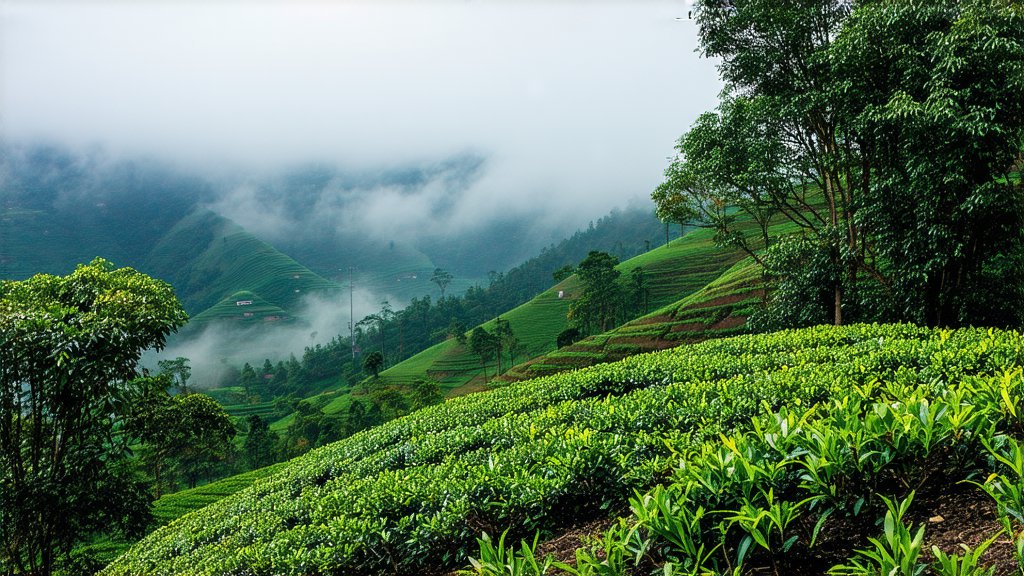
In the lush, verdant hills of Anhui province lies the birthplace of an exquisite and lesser-known gem within the vast spectrum of Chinese teas—Huangshan Mao Feng Yellow Tea. This article embarks on a journey to unveil the historical significance, varieties, intricate production process, and the art of appreciating this unique yellow tea variety to an international audience.
A Glimpse into History
Huangshan Mao Feng, literally translating to "Mao Peak from Huang Mountain," has a storied past that intertwines with the rich tapestry of Chinese tea culture. Its origins can be traced back to the early Tang Dynasty (618-907 AD), a period when tea was not only a popular beverage but also a symbol of sophistication and refinement. The tea gained prominence during the Ming Dynasty (1368-1644 AD) as one of the prestigious tribute teas presented to the imperial court. Over centuries, it has evolved, yet retained its traditional charm, becoming a testament to China's enduring tea heritage.
Varieties and Characteristics
Huangshan Mao Feng Yellow Tea belongs to the category of yellow teas, which are relatively rare compared to green or black teas. What sets it apart is its distinctive yellow color and unique processing method that imparts a mellow flavor profile. Unlike other tea categories, yellow tea undergoes a 'sealing yellow' process where the freshly picked leaves are lightly steamed or pan-fried to initiate enzymatic activity without fully stopping oxidation. This results in a partial oxidation, giving the tea its characteristic yellow hue and a sweet, fruity aroma.
There are two main types of Huangshan Mao Feng: Yinzhen (Silver Needle) and Mengding (Grade One). Yinzhen consists solely of the tender buds, offering a more delicate taste and aroma, while Mengding includes both buds and young leaves, providing a fuller body and richer flavor. Each type showcases the terroir ofs Huangshan, with subtle variations influenced by altitude, climate, and soil composition.
Crafting the Perfect Cup: Production Process
The creation of Huangshan Mao Feng Yellow Tea is an art form that requires precision and patience. Here’s a glimpse into its meticulous production process:
-
Plucking: Only the finest, youngest shoots with unopened buds are handpicked, typically between March and May, ensuring optimal freshness and quality.
-
Fixation: The freshly picked leaves undergo a gentle steaming or pan-frying step to halt enzyme activity partially, preserving the greenish-yellow appearance and preventing excessive oxidation.
-
Sealing Yellow: This crucial stage involves wrapping the fixed leaves in cloth or bamboo mats and allowing them to rest for several hours to days, depending on weather conditions and desired flavor intensity. During this time, controlled humidity and temperature facilitate mild enzymatic browning, turning the leaves yellow.
-
Drying: Finally, the sealed yellow leaves are dried slowly over low heat to reduce moisture content, enhancing their shelf life without compromising flavor or aroma.
-
Sorting and Packaging: The dried tea is then meticulously sorted by grade and packed in airtight containers to preserve its freshness until it reaches the consumer.
The Art of Appreciating Huangshan Mao Feng
To truly appreciate Huangshan Mao Feng Yellow Tea, one must engage in the traditional Chinese tea ceremony, which emphasizes mindfulness, respect for nature, and the harmony between man and tea. Here’s how to savor this golden elixir:
-
Preparation: Use a Yixing clay teapot or a clear glass pot to observe the tea's unfurling beauty. Warm the pot with hot water before discarding it.
-
Measurement: For every 150ml of water, use approximately 3-5 grams of tea leaves. Adjust according to personal preference for stronger or lighter brews.
-
Water Temperature: Use water heated to around 80-85°C (176-185°F). Boiling water may scorch the delicate leaves.
-
Steeping: Infuse the leaves for about 2-3 minutes for the first brew. Subsequent infusions can be extended gradually as the leaves open up, revealing deeper flavors.
-
Observation: Watch as the tightly rolled leaves gently unfurl, releasing their golden essence into the water. The liquor should exhibit a bright yellow-green color.
-
Aroma and Taste: Inhale deeply to capture the sweet, floral notes before taking a sip. Let the tea roll over your tongue, noting its smooth texture and subtle sweetness, often accompanied by hints of honey and fruit.
-
Multiple Infusions: Huangshan Mao Feng can be steeped multiple times, each infusion revealing new dimensions of flavor and complexity.
In conclusion, Huangshan Mao Feng Yellow Tea stands as a testament to China's profound tea culture and the artistry involved in tea making. Its history spans centuries, its production is a labor of love, and its consumption is an invitation to slow down and savor life's simple pleasures. As you embark on your own exploration of this golden treasure, remember that each cup tells a story—a narrative woven from the mists of Huangshan, the hands of skilled artisans, and the heart of a tradition that continues to enchant tea lovers worldwide.
Keywords: Huangshan, Mengding, sealing yellow process, Chinese tea culture, Yinzhen grade, tea ceremony